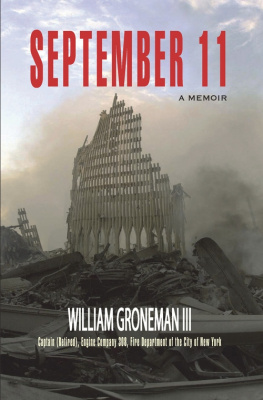Eyewitness
to the
Alamo
Revised Edition
by Bill Groneman

Copyright 2001, Bill Groneman
All rights reserved. No part of this book may be reproduced in any form or by any electronic or mechanical means, including information storage and retrieval systems, without written permission from the publisher, except by a reviewer who may quote passages in a review.
Published by Republic of Texas Press
An imprint of The Rowman & Littlefield Publishing Group, Inc.
4501 Forbes Boulevard, Suite 200
Lanham, MD 20706
Distributed by NATIONAL BOOK NETWORK
Library of Congress Cataloging-in-Publication Data
Groneman, Bill.
Eyewitness to the Alamo / Bill Groneman.Rev. ed.
p. cm.
Includes bibliographical references (p.) and index.
ISBN 1-55622-846-5
ISBN: 978-1-55622-846-9
1. Alamo (San Antonio, Tex.)Siege, 1836Personal narratives. I. Title.
F390.G85
976.4'03dc21 | 2001 | 2001019400
CIP |
 The paper used in this publication meets the minimum requirements of American National Standard for Information SciencesPermanence of Paper for Printed Library Materials, ANSI/NISO Z39.48-1992.
The paper used in this publication meets the minimum requirements of American National Standard for Information SciencesPermanence of Paper for Printed Library Materials, ANSI/NISO Z39.48-1992.
Manufactured in the United States of America.
For my wife Kelly
and my daughter Katie
The task was a laborious one because eyewitnesses
of the same occurrence gave different accounts of
them as they remembered, or were interested in
the actions of one side or the other.
Thucydides
Contents
Chapter One
The Siege
Chapter Two
1836
Chapter Three
19th Century
Chapter Four
20th Century
Chapter Five
The Alamo
Foreword
C. L. Sonnichsen, that grand old man of southwestern history who passed away several years ago, would have loved Bill Groneman. Sonnichsen, who as president of the Western History Association and as a mentor to me in the Western Writers of America greatly influenced my own views on academic historians and so-called popular historians, was a champion of what he called grassroots historians. Although Doc Sonnichsen, as he was called by his many admirers, had a Ph.D. from Harvard, he despaired of an academe where highly specialized scholars have left the busy world behind, communicate only with each other, and speak a private language understood only by themselves. Doc wrote those words back in 1981, before the academic community, and especially practitioners of western history, descended to far more pathetic levels of self-congratulation and total isolation from the interests of the intelligent reading public.
Sonnichsen defined grassroots historians, and he considered himself one of them, as amateurs, untrained enthusiasts, buffs, and ordinary citizens who want to know about some special corner of the pastgrassroots types who spend long hours, happy and exciting to them, in county courthouses, old newspaper files, state archives, and regional libraries. Not all of them are either humble or obscure. There is a wide gray area between the black of the academic specialist and the white of the busy buff.
Bill Groneman is the perfect exemplar of Doc Sonnichsens grassroots historian. Unlike so many who labor in the fields without recognition, Groneman has had a profound impact upon Texas history and, most especially, the study of the epic battle of the Alamo. When, in 1994, Groneman published a provocative little volume entitled Defense of a Legend, arguing that the Alamo journal of Mexican officer Jos Enrique de la Pea, published in 1975 by Texas A&M University Press, was a fraud, he stirred up a firestorm. (One minor brushfire was his psychological interpretation of this historian in the following: When Professor Paul Andrew Hutton, a leading proponent of the execution theory, wrote an article on Crockett for Texas Monthly magazine, he proclaimed that when he began writing his article, he sought to dismantle him, to free myself from the shackles of childhood hero worship. Professor Hutton was one of the major voices decrying everyone elses fragile psyches, yet it was he who seemed to be trying to purge himself of childhood demons.) Groneman and I met soon after his book was released and struck up a friendship based on our mutual obsession with Crockett and the Alamo.
While I continued to disagree with his interpretation of the Pea document, I could not help but admire his love of history and his passion to uncover the truth. He raised serious questions about the document that have never been completely answered despite rather savage attacks by academic rivals and a conference on the Pea journal at the University of Texas that studiously avoided inviting Groneman to participate.
Gronemans work stirred up a grand debate that is ongoing, created a cottage publishing industry around the questions he raised, and helped to enhance the career paths of his academic critics by adding new lines to their vitaes. All this swirling controversy he faced with a remarkably dry sense of humor and a determination to force his opponents to produce real evidence to back up their interpretations. He also no longer stands alone, for some other noted authors, such as the historian William C. Davis and the novelist Stephen Harrigan, have often sided with him.
Groneman and I have shared a few debate platforms, where I learned firsthand the subtle bite of his dry wit. In one particularly clever exchange in the February 1999 Wild West magazine, he was asked when taking a historian like Hutton to task, werent you intimidated? He responded, with classic Groneman style, Not really, because we were Alamo buffs, members of this Alamo Society. I wasnt thinking about his national reputation. I didnt know he was that famous at that time. I didnt know he was that famous until he told me.
The Crockett debate brought Groneman and Defense of a Legend considerable notoriety, but he has done other important history work including Alamo Defenders in 1990, Battlefields of Texas in 1998, and Death of a Legend in 1999. All this has been accomplished while pursuing a career with the New York City Fire Department, where he currently ranks as Captain.
Gronemans most impressive workand most useful to the student of the Alamo or casual reader interested in exploring this story in more detailis the book you hold in your handEyewitness to the Alamo, first published in 1996. It is rather remarkable that an eminently useful anthology such as this had not been previously published. John Rios Readings on the Alamo (1987) took a historiographical approach, while Timothy Matovinas The Alamo Remembered (1995) dealt only with Tejano accounts central to the formation of an ethnic consciousness. Gronemans careful selection of contemporary accounts of the storied battle, both authentic and fanciful, still stands alone as the best single volume of its kind available.
Gronemans thoughtful commentary on these narratives adds considerable value to the book. His organization is straightforward and clear: Part one deals with letters written at the time of the battle by participants; part two with accounts given immediately after the battle; part three with nineteenth-century memoirs; and a final section with twentieth-century appearances of previously unknown accounts. It is extraordinary just how much new material on the battle is only now coming to light. Future research in Mexican archives will undoubtedly yield even more of value. All of this new material, as Groneman makes clear, is fundamentally changing our understanding of what was once assumed to be a well-known story. Much of this new research and many of the new questions now being asked are the result of the new interest in the topic inspired by Gronemans books.













 The paper used in this publication meets the minimum requirements of American National Standard for Information SciencesPermanence of Paper for Printed Library Materials, ANSI/NISO Z39.48-1992.
The paper used in this publication meets the minimum requirements of American National Standard for Information SciencesPermanence of Paper for Printed Library Materials, ANSI/NISO Z39.48-1992.